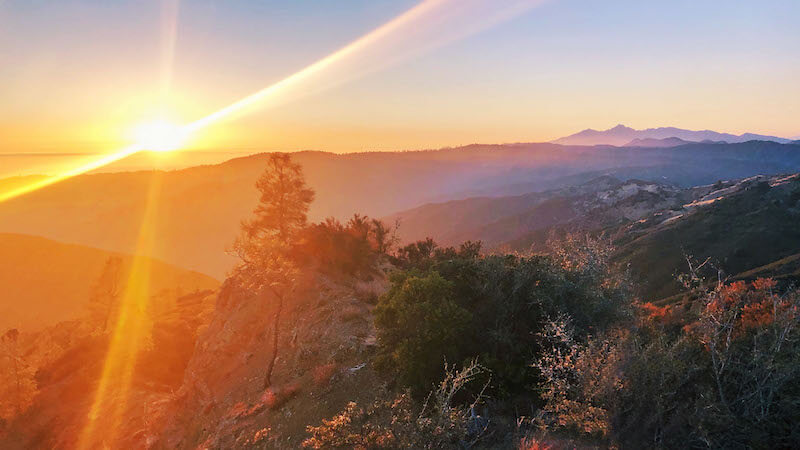
The land occupied by the Esalen Institute campus was a place of healing and renewal for the Esselen tribe long before the institute’s founding in 1962. The tribe would send their people to these lands to heal. It was like sending someone to the hospital. The people would go through ceremony and cleanse themselves in the waters of the hot springs. Those who were healed would leave, and those who could not heal were buried on the land. For more than 6000 years, The Esselen Tribe of Monterey County has continuously inhabited this land as well as territory stretching from the Santa Lucia Mountains to the Big Sur coast, and from Carmel Mission South, 40 miles to Pacific Valley. This is still the place they call home.
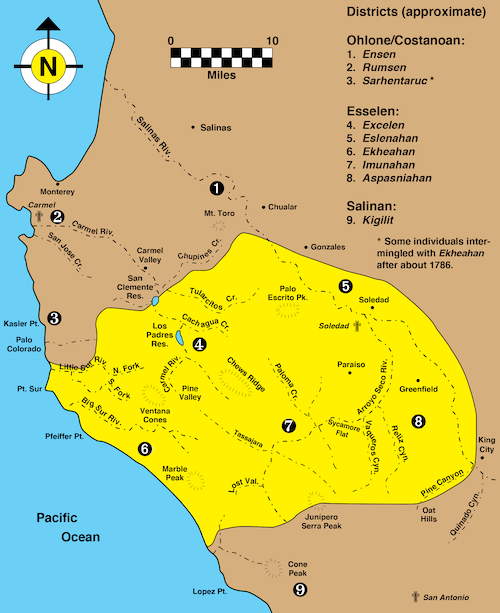
Writer Eric Simons condenses this history into a timeline that centers the Esselen people and their experience of the violent disruption to their way of life by the forces of Spanish, Mexican, and American colonization.
For at least 6,000 years a unique Hokan-speaking people called the Esselen lived in villages throughout the coastal mountains around Big Sur. Their creation stories centered on the mountain later called Pico Blanco, high up in the hills with a view west toward the coast and east toward the headwaters of the Little Sur River. Within a few decades of their arrival in 1769, the Spanish forced these people into new missions in Carmel, Soledad, and Jolon. The Spanish separated families, banned the speaking of the Esselen language, and banned the practice of cultural traditions. When people ran away from the missions or hid in the remote corners of the Santa Lucia Mountains, soldiers hunted them.
These events forcibly estranged the Esselen people from their land for about 250 years. Indigenous tribes across what we know today as California experienced the same systems of colonization and forced removal as the Esselen tribe.
Historians from the State of California Native American Heritage Commission have first person accounts from Indigenous people who experienced this intentional dislocation. One story, as told by an Oustemah/Nisenan woman named Betsy, recounts the terror of the settler’s arrival.
A life of ease and peace was interrupted when I was a little girl by the arrival of the whitemen. Each day the population increased and the Indians feared the invaders and great consternation prevailed… as gold excitement advanced, we were moved again and again, each time in haste. Indian children… when taken into town would blacken their faces with dirt so the newcomers would not steal them…
It is in the context of this history that the Esselen Tribe secured the return of more than 1,000 acres of their traditional, sacred lands after more than 250 years of being systematically exiled. These lands are now available to other landless tribes on the Central Coast for ceremonial purposes, traditional plant gathering, and burial for tribal members.
To heal and honor both our present and our future, we must understand the hardest parts of our past. The shadow parts of ourselves cannot be erased. This work calls us to courage. It demands that we get comfortable with being uncomfortable. This is why we are called to lift up the history of the Indigenous people of the Central Coast, along with the broader history of the Indigenous peoples of California to begin the cycle of healing and move toward repair.
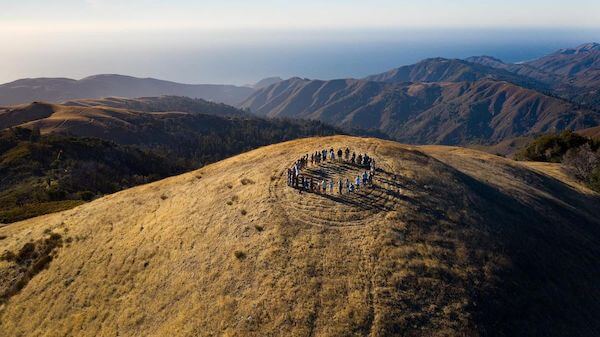
If you want to begin your own journey into understanding the past and the present of the Esselen Tribe of Monterey County and other Indigenous tribes across the state, we’ve provided links to several educational resources to help you along your way.
Learn about the Esselen Tribe of Monterey County
Esselen Tribe of Monterey County History
Esselen Tribal Lands Conservation Project
Indigenous Peoples of the Bay Area
Costanoan Rumsen Carmel Tribe
Federated Indians of Graton Rancheria
The History of Indigenous Peoples of California
History of Native California (Humboldt State University)
California Native Perspectives (California Indian Museum and Cultural Center)
We Are (Still) Here: Indigenous Peoples of Los Angeles and Ventura Counties (Caltrans District 7 Museum)
Indigenous Peoples of California: Related Resources at The Bancroft Library (UC Berkeley)
California Indian Genocide and Resilience (Bioneers)
Samuel Gensaw III (Yurok) on the Restorative Revolution (For the Wild podcast)
Find out what Indigenous land you live on and learn more about the Indigenous people in your area
Native Land Search Wordpress Plug-in from Pipe Wrench Magazine
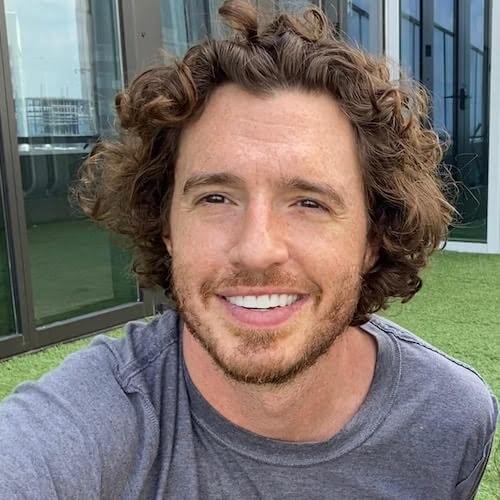
“Remembering to be as self compassionate as I can and praying to the divine that we're all a part of.”
–Aaron
“Prayer, reading, meditation, walking.”
–Karen
“Erratically — which is an ongoing stream of practice to find peace.”
–Charles
“Try on a daily basis to be kind to myself and to realize that making mistakes is a part of the human condition. Learning from our mistakes is a journey. But it starts with compassion and caring. First for oneself.”
–Steve
“Physically: aerobic exercise, volleyball, ice hockey, cycling, sailing. Emotionally: unfortunately I have to work to ‘not care’ about people or situations which may end painfully. Along the lines of ‘attachment is the source of suffering’, so best to avoid it or limit its scope. Sad though because it could also be the source of great joy. Is it worth the risk?“
–Rainer
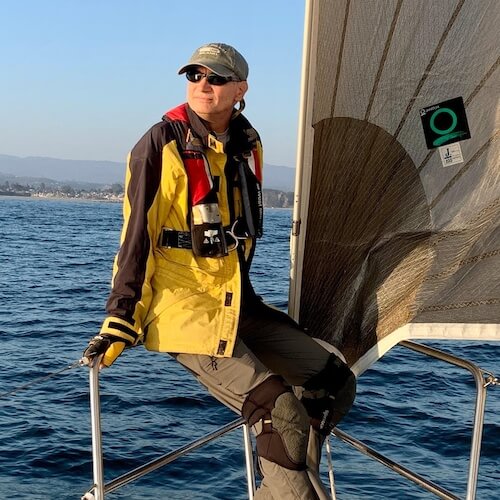

“It's time for my heart to be nurtured on one level yet contained on another. To go easy on me and to allow my feelings to be validated, not judged harshly. On the other hand, to let the heart rule with equanimity and not lead the mind and body around like a master.”
–Suzanne
“I spend time thinking of everything I am grateful for, and I try to develop my ability to express compassion for myself and others without reservation. I take time to do the things I need to do to keep myself healthy and happy. This includes taking experiential workshops, fostering relationships, and participating within groups which have a similar interest to become a more compassionate and fulfilled being.“
–Peter
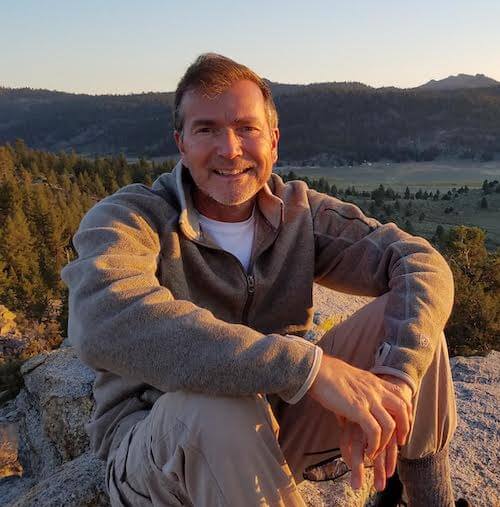
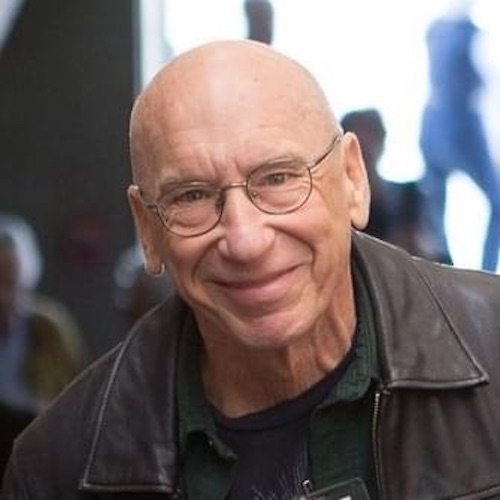
“Self-forgiveness for my own judgments. And oh yeah, coming to Esalen.”
–David B.
“Hmm, this is a tough one! I guess I take care of my heart through fostering relationships with people I feel connected to. Spending quality time with them (whether we're on the phone, through messages/letters, on Zoom, or in-person). Being there for them, listening to them, sharing what's going on with me, my struggles and my successes... like we do in the Esalen weekly Friends of Esalen Zoom sessions!”
–Lori

“I remind myself in many ways of the fact that " Love is all there is!" LOVE is the prize and this one precious life is the stage we get to learn our lessons. I get out into nature, hike, camp, river kayak, fly fish, garden, I create, I dance (not enough!), and I remain grateful for each day, each breath, each moment. Being in the moment, awake, and remembering the gift of life and my feeling of gratitude for all of creation.”
–Steven
“My physical heart by limiting stress and eating a heart-healthy diet. My emotional heart by staying in love with the world and by knowing that all disappointment and loss will pass.“
–David Z.
Today, September 29, is World Heart Day. Strike up a conversation with your own heart and as you feel comfortable, encourage others to do the same. As part of our own transformations and self-care, we sometimes ask for others to illuminate and enliven our hearts or speak our love language.
What if we could do this for ourselves too, even if just for today… or to start a heart practice, forever?

The land occupied by the Esalen Institute campus was a place of healing and renewal for the Esselen tribe long before the institute’s founding in 1962. The tribe would send their people to these lands to heal. It was like sending someone to the hospital. The people would go through ceremony and cleanse themselves in the waters of the hot springs. Those who were healed would leave, and those who could not heal were buried on the land. For more than 6000 years, The Esselen Tribe of Monterey County has continuously inhabited this land as well as territory stretching from the Santa Lucia Mountains to the Big Sur coast, and from Carmel Mission South, 40 miles to Pacific Valley. This is still the place they call home.

Writer Eric Simons condenses this history into a timeline that centers the Esselen people and their experience of the violent disruption to their way of life by the forces of Spanish, Mexican, and American colonization.
For at least 6,000 years a unique Hokan-speaking people called the Esselen lived in villages throughout the coastal mountains around Big Sur. Their creation stories centered on the mountain later called Pico Blanco, high up in the hills with a view west toward the coast and east toward the headwaters of the Little Sur River. Within a few decades of their arrival in 1769, the Spanish forced these people into new missions in Carmel, Soledad, and Jolon. The Spanish separated families, banned the speaking of the Esselen language, and banned the practice of cultural traditions. When people ran away from the missions or hid in the remote corners of the Santa Lucia Mountains, soldiers hunted them.
These events forcibly estranged the Esselen people from their land for about 250 years. Indigenous tribes across what we know today as California experienced the same systems of colonization and forced removal as the Esselen tribe.
Historians from the State of California Native American Heritage Commission have first person accounts from Indigenous people who experienced this intentional dislocation. One story, as told by an Oustemah/Nisenan woman named Betsy, recounts the terror of the settler’s arrival.
A life of ease and peace was interrupted when I was a little girl by the arrival of the whitemen. Each day the population increased and the Indians feared the invaders and great consternation prevailed… as gold excitement advanced, we were moved again and again, each time in haste. Indian children… when taken into town would blacken their faces with dirt so the newcomers would not steal them…
It is in the context of this history that the Esselen Tribe secured the return of more than 1,000 acres of their traditional, sacred lands after more than 250 years of being systematically exiled. These lands are now available to other landless tribes on the Central Coast for ceremonial purposes, traditional plant gathering, and burial for tribal members.
To heal and honor both our present and our future, we must understand the hardest parts of our past. The shadow parts of ourselves cannot be erased. This work calls us to courage. It demands that we get comfortable with being uncomfortable. This is why we are called to lift up the history of the Indigenous people of the Central Coast, along with the broader history of the Indigenous peoples of California to begin the cycle of healing and move toward repair.

If you want to begin your own journey into understanding the past and the present of the Esselen Tribe of Monterey County and other Indigenous tribes across the state, we’ve provided links to several educational resources to help you along your way.
Learn about the Esselen Tribe of Monterey County
Esselen Tribe of Monterey County History
Esselen Tribal Lands Conservation Project
Indigenous Peoples of the Bay Area
Costanoan Rumsen Carmel Tribe
Federated Indians of Graton Rancheria
The History of Indigenous Peoples of California
History of Native California (Humboldt State University)
California Native Perspectives (California Indian Museum and Cultural Center)
We Are (Still) Here: Indigenous Peoples of Los Angeles and Ventura Counties (Caltrans District 7 Museum)
Indigenous Peoples of California: Related Resources at The Bancroft Library (UC Berkeley)
California Indian Genocide and Resilience (Bioneers)
Samuel Gensaw III (Yurok) on the Restorative Revolution (For the Wild podcast)
Find out what Indigenous land you live on and learn more about the Indigenous people in your area
Native Land Search Wordpress Plug-in from Pipe Wrench Magazine

“Remembering to be as self compassionate as I can and praying to the divine that we're all a part of.”
–Aaron
“Prayer, reading, meditation, walking.”
–Karen
“Erratically — which is an ongoing stream of practice to find peace.”
–Charles
“Try on a daily basis to be kind to myself and to realize that making mistakes is a part of the human condition. Learning from our mistakes is a journey. But it starts with compassion and caring. First for oneself.”
–Steve
“Physically: aerobic exercise, volleyball, ice hockey, cycling, sailing. Emotionally: unfortunately I have to work to ‘not care’ about people or situations which may end painfully. Along the lines of ‘attachment is the source of suffering’, so best to avoid it or limit its scope. Sad though because it could also be the source of great joy. Is it worth the risk?“
–Rainer


“It's time for my heart to be nurtured on one level yet contained on another. To go easy on me and to allow my feelings to be validated, not judged harshly. On the other hand, to let the heart rule with equanimity and not lead the mind and body around like a master.”
–Suzanne
“I spend time thinking of everything I am grateful for, and I try to develop my ability to express compassion for myself and others without reservation. I take time to do the things I need to do to keep myself healthy and happy. This includes taking experiential workshops, fostering relationships, and participating within groups which have a similar interest to become a more compassionate and fulfilled being.“
–Peter


“Self-forgiveness for my own judgments. And oh yeah, coming to Esalen.”
–David B.
“Hmm, this is a tough one! I guess I take care of my heart through fostering relationships with people I feel connected to. Spending quality time with them (whether we're on the phone, through messages/letters, on Zoom, or in-person). Being there for them, listening to them, sharing what's going on with me, my struggles and my successes... like we do in the Esalen weekly Friends of Esalen Zoom sessions!”
–Lori

“I remind myself in many ways of the fact that " Love is all there is!" LOVE is the prize and this one precious life is the stage we get to learn our lessons. I get out into nature, hike, camp, river kayak, fly fish, garden, I create, I dance (not enough!), and I remain grateful for each day, each breath, each moment. Being in the moment, awake, and remembering the gift of life and my feeling of gratitude for all of creation.”
–Steven
“My physical heart by limiting stress and eating a heart-healthy diet. My emotional heart by staying in love with the world and by knowing that all disappointment and loss will pass.“
–David Z.
Today, September 29, is World Heart Day. Strike up a conversation with your own heart and as you feel comfortable, encourage others to do the same. As part of our own transformations and self-care, we sometimes ask for others to illuminate and enliven our hearts or speak our love language.
What if we could do this for ourselves too, even if just for today… or to start a heart practice, forever?

The land occupied by the Esalen Institute campus was a place of healing and renewal for the Esselen tribe long before the institute’s founding in 1962. The tribe would send their people to these lands to heal. It was like sending someone to the hospital. The people would go through ceremony and cleanse themselves in the waters of the hot springs. Those who were healed would leave, and those who could not heal were buried on the land. For more than 6000 years, The Esselen Tribe of Monterey County has continuously inhabited this land as well as territory stretching from the Santa Lucia Mountains to the Big Sur coast, and from Carmel Mission South, 40 miles to Pacific Valley. This is still the place they call home.

Writer Eric Simons condenses this history into a timeline that centers the Esselen people and their experience of the violent disruption to their way of life by the forces of Spanish, Mexican, and American colonization.
For at least 6,000 years a unique Hokan-speaking people called the Esselen lived in villages throughout the coastal mountains around Big Sur. Their creation stories centered on the mountain later called Pico Blanco, high up in the hills with a view west toward the coast and east toward the headwaters of the Little Sur River. Within a few decades of their arrival in 1769, the Spanish forced these people into new missions in Carmel, Soledad, and Jolon. The Spanish separated families, banned the speaking of the Esselen language, and banned the practice of cultural traditions. When people ran away from the missions or hid in the remote corners of the Santa Lucia Mountains, soldiers hunted them.
These events forcibly estranged the Esselen people from their land for about 250 years. Indigenous tribes across what we know today as California experienced the same systems of colonization and forced removal as the Esselen tribe.
Historians from the State of California Native American Heritage Commission have first person accounts from Indigenous people who experienced this intentional dislocation. One story, as told by an Oustemah/Nisenan woman named Betsy, recounts the terror of the settler’s arrival.
A life of ease and peace was interrupted when I was a little girl by the arrival of the whitemen. Each day the population increased and the Indians feared the invaders and great consternation prevailed… as gold excitement advanced, we were moved again and again, each time in haste. Indian children… when taken into town would blacken their faces with dirt so the newcomers would not steal them…
It is in the context of this history that the Esselen Tribe secured the return of more than 1,000 acres of their traditional, sacred lands after more than 250 years of being systematically exiled. These lands are now available to other landless tribes on the Central Coast for ceremonial purposes, traditional plant gathering, and burial for tribal members.
To heal and honor both our present and our future, we must understand the hardest parts of our past. The shadow parts of ourselves cannot be erased. This work calls us to courage. It demands that we get comfortable with being uncomfortable. This is why we are called to lift up the history of the Indigenous people of the Central Coast, along with the broader history of the Indigenous peoples of California to begin the cycle of healing and move toward repair.

If you want to begin your own journey into understanding the past and the present of the Esselen Tribe of Monterey County and other Indigenous tribes across the state, we’ve provided links to several educational resources to help you along your way.
Learn about the Esselen Tribe of Monterey County
Esselen Tribe of Monterey County History
Esselen Tribal Lands Conservation Project
Indigenous Peoples of the Bay Area
Costanoan Rumsen Carmel Tribe
Federated Indians of Graton Rancheria
The History of Indigenous Peoples of California
History of Native California (Humboldt State University)
California Native Perspectives (California Indian Museum and Cultural Center)
We Are (Still) Here: Indigenous Peoples of Los Angeles and Ventura Counties (Caltrans District 7 Museum)
Indigenous Peoples of California: Related Resources at The Bancroft Library (UC Berkeley)
California Indian Genocide and Resilience (Bioneers)
Samuel Gensaw III (Yurok) on the Restorative Revolution (For the Wild podcast)
Find out what Indigenous land you live on and learn more about the Indigenous people in your area
Native Land Search Wordpress Plug-in from Pipe Wrench Magazine

“Remembering to be as self compassionate as I can and praying to the divine that we're all a part of.”
–Aaron
“Prayer, reading, meditation, walking.”
–Karen
“Erratically — which is an ongoing stream of practice to find peace.”
–Charles
“Try on a daily basis to be kind to myself and to realize that making mistakes is a part of the human condition. Learning from our mistakes is a journey. But it starts with compassion and caring. First for oneself.”
–Steve
“Physically: aerobic exercise, volleyball, ice hockey, cycling, sailing. Emotionally: unfortunately I have to work to ‘not care’ about people or situations which may end painfully. Along the lines of ‘attachment is the source of suffering’, so best to avoid it or limit its scope. Sad though because it could also be the source of great joy. Is it worth the risk?“
–Rainer


“It's time for my heart to be nurtured on one level yet contained on another. To go easy on me and to allow my feelings to be validated, not judged harshly. On the other hand, to let the heart rule with equanimity and not lead the mind and body around like a master.”
–Suzanne
“I spend time thinking of everything I am grateful for, and I try to develop my ability to express compassion for myself and others without reservation. I take time to do the things I need to do to keep myself healthy and happy. This includes taking experiential workshops, fostering relationships, and participating within groups which have a similar interest to become a more compassionate and fulfilled being.“
–Peter


“Self-forgiveness for my own judgments. And oh yeah, coming to Esalen.”
–David B.
“Hmm, this is a tough one! I guess I take care of my heart through fostering relationships with people I feel connected to. Spending quality time with them (whether we're on the phone, through messages/letters, on Zoom, or in-person). Being there for them, listening to them, sharing what's going on with me, my struggles and my successes... like we do in the Esalen weekly Friends of Esalen Zoom sessions!”
–Lori

“I remind myself in many ways of the fact that " Love is all there is!" LOVE is the prize and this one precious life is the stage we get to learn our lessons. I get out into nature, hike, camp, river kayak, fly fish, garden, I create, I dance (not enough!), and I remain grateful for each day, each breath, each moment. Being in the moment, awake, and remembering the gift of life and my feeling of gratitude for all of creation.”
–Steven
“My physical heart by limiting stress and eating a heart-healthy diet. My emotional heart by staying in love with the world and by knowing that all disappointment and loss will pass.“
–David Z.
Today, September 29, is World Heart Day. Strike up a conversation with your own heart and as you feel comfortable, encourage others to do the same. As part of our own transformations and self-care, we sometimes ask for others to illuminate and enliven our hearts or speak our love language.
What if we could do this for ourselves too, even if just for today… or to start a heart practice, forever?